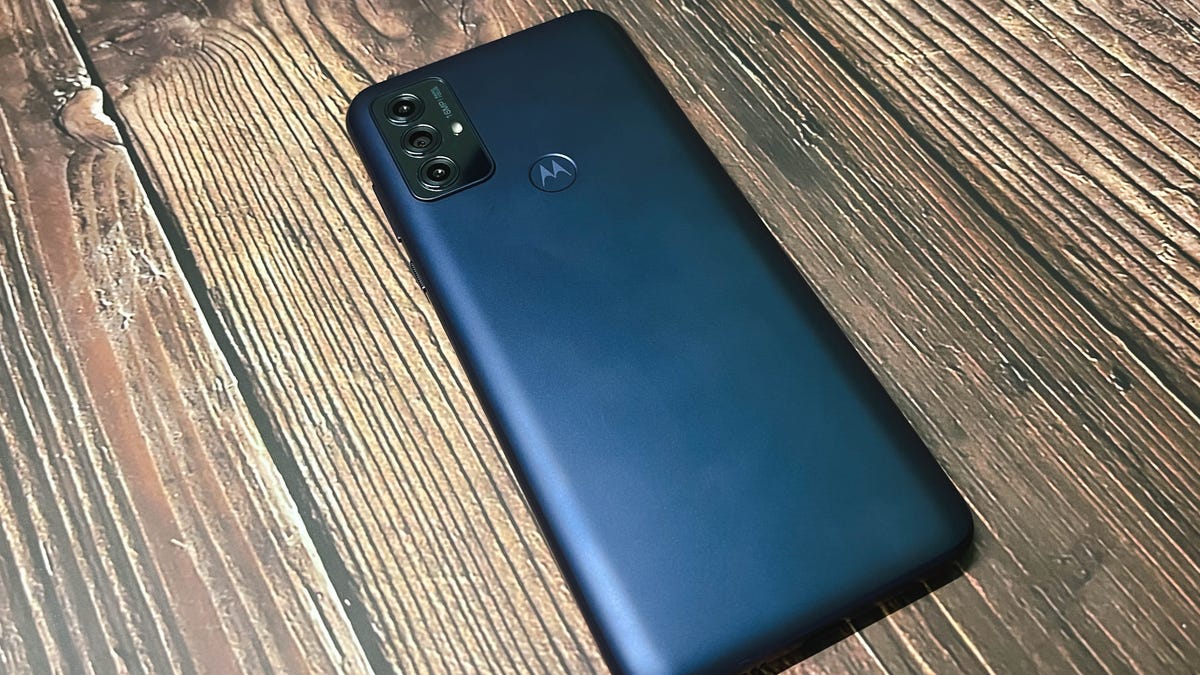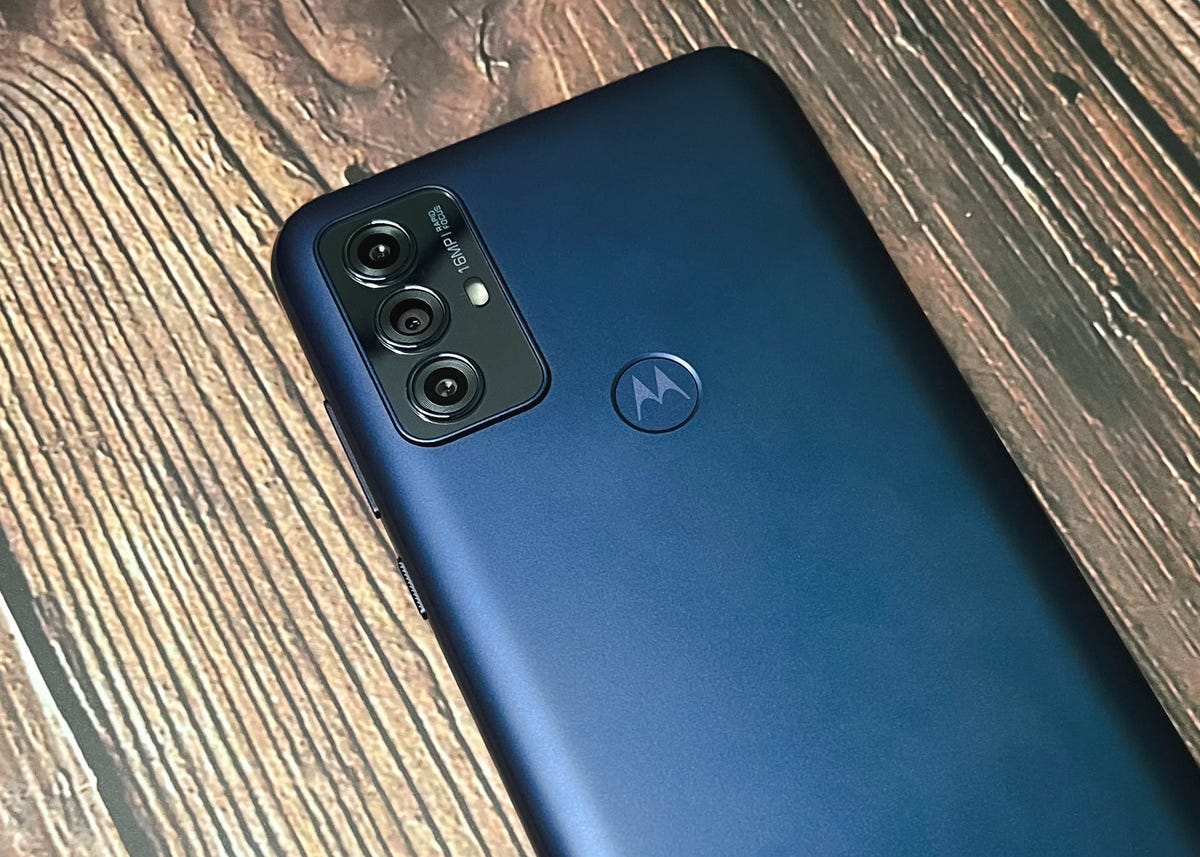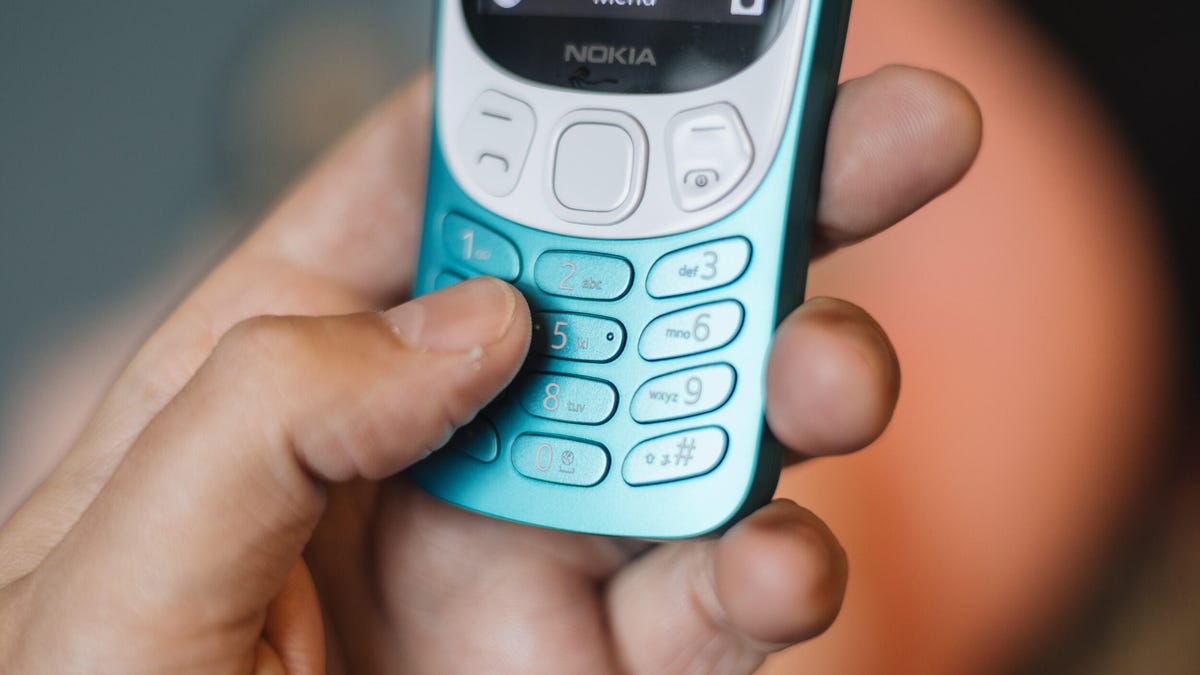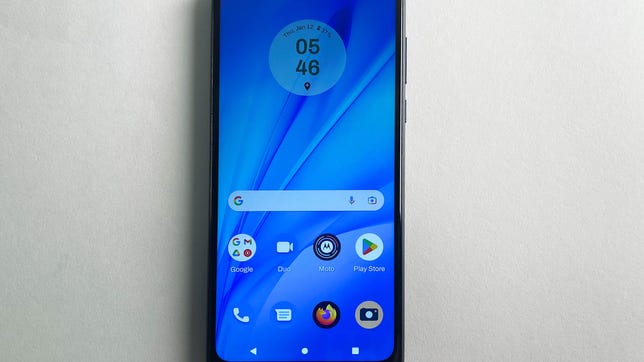Technologies
Moto G Play (2023) Review: Low Price, Low on Function
The essentials-only Motorola phone cuts to the bone in order to hit its $170 price.

The Moto G Play for 2023 costs $170 (or even less at Amazon), making it one of the cheapest new phones you can get right now, and without the bloatware or wireless carrier restrictions we sometimes see on lower-priced devices. With a decent set of specs for the price — including a triple camera system with a 16-megapixel main camera, a 6.5-inch display with a 90Hz refresh rate and a 5,000-mAh battery that provides nearly three days of battery life — this should have been an attractive option for anyone looking for a decent, no-frills phone.
However, this phone has a number of performance issues that make it frustrating to use. And on top of that, Motorola chose to drop one of its best Moto gestures: twisting the phone to quickly open its camera. While some might consider these gestures a gimmick, they have been a signature element of Motorola’s phones for nearly a decade. Other gestures like «chop to turn on flashlight» are still here, making the absence of the camera gesture even more glaring.
Despite these important drawbacks, the 2023 Moto G Play does have some positive attributes. The battery life is great, the software is a fairly clean version of Android 12 and you’ll find rare ports like a headphone jack and microSD card slot for storage expansion. But the phone will only get one major software update to Android 13, which is less than I’d like to see but typical for this price range, as well as three years of security updates.
Yet every perk I list comes with another problem, which is important to consider if you’re tempted by the Moto G Play because of its low price.
Like
- Long battery life
- Clean version of Android 12
- Three years of security updates
Don’t Like
- Frequent lag, issues loading software
- Questionable refresh rate
- No «twist to open camera» gesture
Moto G Play design and performance
The Moto G Play looks nice for a phone that costs just $170. The Navy Blue color of its plastic body provides a hint of personality, while the phone’s low-resolution 720p display includes a screen cutout for the 5-megapixel front-facing camera. The fingerprint sensor is located in my favorite spot on an Android phone — the back.
But the problems begin once you start using the phone. The phone’s MediaTek Helio G37 processor and 3GB of RAM weren’t powerful enough to juggle multiple apps easily. In some cases, it wouldn’t even load certain apps. This was particularly bizarre considering it loaded a 3D game like Crazy Taxi (admittedly an oldie but still a goodie), but couldn’t run other modern 2D games like Exploding Kittens. With the phone’s tiny 32GB of storage, I’m lucky to even fit a couple games onto the Moto G Play, although there is a microSD card slot for storage expansion.
Geekbench V.5.0 single-core
Note:
Longer bars indicate better performance
Geekbench V.5.0 multicore
Note:
Longer bars indicate better performance
Email, news and video-streaming apps fared better in terms of performance, but not by much. Even though the Moto G Play touts a 90Hz refresh rate, which should smooth out animations, there is a lot of noticeable lag. I couldn’t even tell when the refresh rate reached 90Hz. The Settings menu lets you choose between «Auto» and «60 Hz,» with the former dynamically changing the refresh rate based on what you are doing. Having an auto setting does make sense, but a lot of the cheaper Android phones I’ve used also include the option to set the phone to a consistent 90Hz, alongside a 60Hz option for preserving battery life.
This brings me back to the phone’s 5,000-mAh battery — a bright spot considering it easily lasted two days on a full charge during my testing. I think it’s possible for the battery to make it to a third day, mostly because of how underpowered this device is. I typically got around three hours of screen time per day on the device during my testing, which included streaming, shooting photos and trying to play games for this review.
During a more active session on the phone, in which I streamed 22 minutes of a TV show at 100% brightness and then took a 24-minute video call, the battery dropped from 59% to 46%. On less active days, in which the phone was used primarily for listening to music while commuting, reading news articles and light texting, I could end the day with just over 50% remaining.
Charging times for the phone are generally less impressive than battery life. With the included 10-watt charger, it typically took just over an hour to charge from zero to 50%. Getting to 100% would take just over 2 hours, 30 minutes. When I tested charging speeds with my 18-watt charger, the results were slightly faster. The phone would get from zero to 66% after an hour and finish charging just past the two-hour mark.


The Moto G Play has three cameras, anchored by a 16-megapixel main camera.
Mike Sorrentino/CNETMoto G Play cameras
The Moto G Play has a triple-camera system anchored by a main 16-megapixel camera, which is accompanied by a 2-megapixel macro camera and a 2-megapixel depth sensor. But photos are consistently fuzzy, whether I took them indoors, outdoors, in bright environments or in the dark.


A foggy day in New York, taken on the Moto G Play.
Mike Sorrentino/CNETWhile it was nice to see Portrait mode on a phone at this price, I can barely see much of a bokeh effect in my photos. This is especially true when using the 5-megapixel front-facing camera, in which my photos looked consistently muddy.


My friend took a photo of me at the Taco Bell in Times Square using Portrait Mode, but it’s challenging to see if it made a difference.
Mike Sorrentino/CNET

The Moto G Play’s front-facing camera had a tough time keeping me in focus, even in a restaurant with decent lighting.
Mike Sorrentino/CNETI took the Moto G Play with me to Taco Bell — because yes, I’m going to go eat cheap food while reviewing a cheap phone. I had my friend take photos of me using the phone’s Portrait setting. You can sort of see a light blurring effect in the background, but it’s hard to perceive.
In another selfie taken at a restaurant with better lighting than the Taco Bell, I found the selfie camera to have a tough time keeping me in focus.
And when taking photos of my friend’s dog Daisy, the rear cameras struggled to capture much detail of her fur, even when she sat still. In the best of conditions, the phone’s cameras struggle to take sharp photos.


Daisy the dog sat relatively still for this photo, but the Moto G Play’s camera captures minimal detail.
Mike Sorrentino/CNETI compared the photos taken on the Moto G Play against the same images taken on the $160 Samsung Galaxy A03S, and found the picture quality to be roughly comparable for simple static shots. When shooting a bookshelf at CNET’s office, the Moto G Play got slightly more detail of the book covers than the Galaxy A03S, with the latter phone’s image appearing a bit darker.
However, when it comes to a photo with lots of detail and color, such as with this plant wall, the Moto G Play struggles to discern between the different shades of green. Meanwhile the Galaxy A03S performs much better with discerning the darker green shades from the lighter ones, making for a dramatically different photo.
Neither phone’s camera performs especially well, which is a common theme among phones that cost under $200. For me, this places the Moto G Play’s camera photos squarely into the category of being acceptable for group chats, but not much else. It’s going to take a lot of really good lighting and steady hands in order to make the most of these cameras, and that’s more effort than most people are going to want to make.
There are better options, even when you want to save money
Even when you’re looking for the cheapest possible phone, your device still needs to run most apps without issue and take decent-looking photos. I wouldn’t expect a phone that costs less than $200 to run Fortnite at the highest graphics settings, but I am expecting to use apps with minimal lag. While phones at this price are also typically lighter on features, the perks that are available should bring noticeable value to the experience. The Moto G Play’s Portrait mode and high refresh rate don’t succeed in this regard.
Instead of buying the Moto G Play at $170, you’re probably better off saving $10 and getting the $160 Samsung Galaxy A03S. While that phone also has unimpressive cameras, it was at least able to multitask more easily.
Although I haven’t reviewed it yet, you might also consider the $199 Samsung Galaxy A14 5G, since it has 64GB of storage and 5G connectivity. Later this year, a number of TCL 40 phones will arrive in the US, which will include 5G and 128GB of storage for under $200. Those devices might be worth waiting for if you aren’t in dire need of a cheap phone right now.
Moto G Play (2023) vs. Samsung Galaxy A03S, TCL Stylus 5G, OnePlus Nord N300 5G
| Moto G Play (2023) | Samsung Galaxy A03S | TCL Stylus 5G | OnePlus Nord N300 5G | |
|---|---|---|---|---|
| Display size, type resolution, refresh rate | 6.5-inch IPS TFT LCD; 1,600×720 pixels; 90Hz refresh rate | 6.5-inch LCD; 1,600×720 pixels | 6.81-inch; 2,400×1,080 pixels | 6.56-inch IPS LCD display; 720p resolution; 90Hz refresh rate |
| Pixel density | 269ppi | 269ppi | 395ppi | 269ppi |
| Dimensions (inches) | 6.58 x 2.95 x 0.36 in | 6.5 x 2.9 x 0.3 in | 6.67 x 3.01 x 0.35 in | 6.4 x 2.9 x 0.3 in |
| Dimensions (millimeters) | 167 x 77 x 9.4 mm | 165.8 x 75.9 x 9.1 mm | 169.6 x 76.5 x 8.9 mm | 163.8 x 75.1 x 7.99 mm |
| Weight (ounces, grams) | 203 g (7.16 oz) | 202g (7.13 oz) | 213g (7.51 oz) | 190g (6.7 oz) |
| Mobile software | Android 12 | Android 11 | Android 12 | Android 12 |
| Camera | 16-megapixel (main), 2-megapixel (macro), 2-megapixel (depth sensor) | 13-megapixel (main), 2-megapixel (depth), 2-megapixel (macro) | 50-megapixel (main), 5-megapixel (wide), 2-megapixel (macro), 2-megapixel (depth sensor) | 48-megapixel (main), 2-megapixel (depth lens) |
| Front-facing camera | 5-megapixel | 5-megapixel | 13-megapixel | 16-megapixel |
| Video capture | 720p at 30 fps | 1080p at 30fps | 1080p at 30fps | 1080p at 30fps |
| Processor | MediaTek Helio G37 | Octa-core processor | MediaTek Dimensity 700 5G | MediaTek Dimensity 810 |
| RAM, storage | 3GB + 32GB | 3GB/32GB | 4GB/128GB | 4GB/64GB |
| Expandable storage | Up to 512GB | Up to 1TB | Up to 2TB | Up to 1TB |
| Battery, charger | 5,000 mAh; 10W charging | 5,000mAh; charger not included, does not support wireless charging | 4,000mAh; 18W charging | 5,000mAh; 33W charging |
| Fingerprint sensor | Rear | Side | Side | Side |
| Connector | USB-C | USB-C | USB-C | USB-C |
| Headphone jack | Yes | Yes | Yes | Yes |
| Special features | 3-day battery life, Moto Gestures, Auto Smile Capture, Portait Mode | Stylus with built-in storage, producitivity software, NxtVision HDR mode | Dual speakers, NFC, Face Unlock, HDR, Portrait, Face retouching | |
| Price off-contract (USD) | $170 | $160 | $258 | $228 |
Technologies
Judge Blocks Texas App Store Age-Check Law
A preliminary injunction found the Texas law, set to begin Jan. 1, is «more likely than not unconstitutional.»

A new Texas state law set to take effect on Jan. 1 would have required app stores to implement age verification processes. But the law has been put on hold, at least temporarily, by a federal court judge.
As reported by the Texas Tribune, Senate Bill 2420, also known as the Texas App Store Accountability Act, is the subject of a temporary injunction issued by US District Judge Robert Pitman.
Pitman said in his decision that the law as written is broad, vague and «more likely than not unconstitutional.» However, he also wrote the court «recognizes the importance of ongoing efforts to better safeguard children when they are on their devices.»
Don’t miss any of our unbiased tech content and lab-based reviews. Add CNET as a preferred Google source.
The Texas law, signed into law by Governor Greg Abbott in May, requires app store operators — including Apple, Google, Nintendo, Steam and more — to build age verification processes for the storefronts and to only allow downloads to minors who obtain parental consent. The injunction is a ruling in an October lawsuit filed by the Computer & Communication Industry Association.
CCIA senior vice president Stephanie Joyce said in a statement, «This Order stops the Texas App Store Accountability Act from taking effect in order to preserve the First Amendment rights of app stores, app developers, parents, and younger internet users. It also protects parents’ inviolate right to use their own judgment in safeguarding their children online using the myriad tools our members provide.»
Other individuals and the advocacy group Students Engaged in Advancing Texas also filed suits over the law, the Texas Tribune reported.
App Store Accountability Act
The bill author, State Senator Angela Paxton, said the bill was meant to give parents «common sense tools to protect their kids and to survive court challenges by those who may have lesser priorities.»
The language of Texas Senate Bill 2420 does not only include mobile app stores from Apple or Google, but any «website, software application, or other electronic service that distributes software applications from the owner or developer of a software application to the user of a mobile device.»
By that definition, websites with links to browser games or mobile game consoles with download options would fall under the Texas law as written. The law also defines mobile devices as including phones and tablets, as well as any other handheld device capable of transmitting or storing information wirelessly.
The parental consent aspect of the law requires those under 18 to have an app store account affiliated with a parent or guardian to purchase or download applications.
Age verification elsewhere
In an effort to keep adult materials out of reach of minors and to protect children from potentially harmful content and interactions, tech companies have been compelled by law or through legal action to verify the age of users.
Roblox, which has a huge audience of minors, began rolling out stricter age verification after investigations and lawsuits hurt its reputation as a safe gaming space. Australia is perhaps the most large-scale example of a government restricting access to online content. In December, Australia began restricting social media access to those 16 and older. Reddit recently challenged that law.
In the US, age verification laws have primarily targeted adult sites. Texas already has a law on the books that requires adult sites to age-block their content. The Supreme Court upheld that law in a June ruling. The UK has also enacted age restriction rules for adult sites as have other US states.
Technologies
Today’s NYT Mini Crossword Answers for Thursday, Dec. 25
Here are the answers for The New York Times Mini Crossword for Dec. 25.

Looking for the most recent Mini Crossword answer? Click here for today’s Mini Crossword hints, as well as our daily answers and hints for The New York Times Wordle, Strands, Connections and Connections: Sports Edition puzzles.
Need some help with today’s Mini Crossword? Of course, there’s a very Christmassy clue involved. And once you solve the entire puzzle, look at the letters used in all the answers and see what they have in common. (5-Across will tell you!) Read on for all the answers. And if you could use some hints and guidance for daily solving, check out our Mini Crossword tips.
If you’re looking for today’s Wordle, Connections, Connections: Sports Edition and Strands answers, you can visit CNET’s NYT puzzle hints page.
Read more: Tips and Tricks for Solving The New York Times Mini Crossword
Let’s get to those Mini Crossword clues and answers.
Mini across clues and answers
1A clue: ___ King Cole, singer with the album «The Magic of Christmas»
Answer: NAT
4A clue: Body drawings, informally
Answer: TATS
5A clue: Letters to ___ (what this Mini was made with)
Answer: SANTA
6A clue: Huge fan, in slang
Answer: STAN
7A clue: «Illmatic» rapper
Answer: NAS
Mini down clues and answers
1D clue: Grandmothers, by another name
Answer: NANAS
2D clue: Abbr. before a name on a memo
Answer: ATTN
3D clue: Org. with long lines around the holidays
Answer: TSA
4D clue: «See ya later!»
Answer: TATA
5D clue: Govt.-issued ID
Answer: SSN
Don’t miss any of our unbiased tech content and lab-based reviews. Add CNET as a preferred Google source.
Technologies
Don’t Let a Border Agent Ruin Your Holiday Trip. Travel With a Burner Phone
Yes, you should leave your main phone at home and take a cheap burner this winter.

Prepare for a whole new level of border-crossing anxiety this holiday season: the high-probability of a phone search. New figures from US Customs and Border Protection say agents aren’t just glancing at your lock screen anymore — they are aggressively ramping up device inspections, even for citizens coming home. We aren’t just talking about a quick scroll through your photos, either. Agents are increasingly using forensic tools to clone and analyze everything on your device.
The stats are genuinely alarming. In just a three-month window this year, nearly 15,000 devices were flagged for searches, with over a thousand subjected to deep-dive data copying. If you’re traveling with your primary phone, you are essentially carrying your entire digital existence into a legal gray zone where privacy is optional.
The smartest defensive play is remarkably low-tech: the burner phone. By traveling with a secondary, stripped-down device, you ensure your private data stays safe at home while you stay connected abroad. But privacy isn’t the only perk. Moving to a «dumb» phone is the ultimate digital detox, helping you escape the notification trap that usually ruins a vacation.
Even figures like Conan O’Brien have ditched the smartphone to cut through the noise. Whether you’re dodging invasive border searches or just trying to enjoy your trip without being glued to a screen, a burner might be the best travel investment you make this year.
Read more: Best Prepaid Phone of 2025
Although carriers have offered prepaid phones since the ’90s, «burner phones» or «burners» became popular in the 2000s following the celebrated HBO series The Wire, where they helped characters avoid getting caught by the police. Although often portrayed in that light, burners aren’t only used by criminals; they’re also used anyone concerned with surveillance or privacy infringement.
What is a burner phone, and how does it work? Here’s everything you need to know about burners and how to get one.
Don’t miss any of our unbiased tech content and lab-based reviews. Add CNET as a preferred Google source.
What is a burner phone?
A burner phone is a cheap prepaid phone with no commitments. It comes with a set number of prepaid call minutes, text messages or data, and it’s designed to be disposed of after use.
Burner phones are typically used when you need a phone quickly, without intentions of long-term use. They’re contract-free, and you can grab them off the counter. They’re called burner phones because you can «burn» them (trash them) after use, and the phone can’t be traced back to you, which makes them appealing to criminals. Of course, those committed to illicit activities often do more than just throw these phones in the trash, and often completely obliterate the SIM cards and other materials by smashing them with a hammer or melting them away.
Burners are different from getting a regular, contract-bound cellphone plan that requires your information to be on file.
Why should you use a burner phone?
Burner phones are an easy way to avoid cellphone contracts or spam that you get on your primary phone number. Burners aren’t linked to your identity, so you can avoid being tracked down or contacted.
You don’t have to dispose of a burner phone after use. You can add more minutes and continue using it. Burner phones can still function as regular phones, minus the hassle of a contract.
You can also get a burner phone as a secondary phone for a specific purpose, like having a spare phone number for two-factor authentication texts, for business or to avoid roaming charges while traveling. Burner phones are often used by anyone concerned with privacy.
Read more: The Data Privacy Tips Digital Security Experts Wish You Knew
Burner phones, prepaid phones, smartphones and burner SIMs: What’s the difference?
Burner phones are cheap phones with simple designs that lack the bells and whistles of a smartphone. Because they’re designed to be disposable, you only get the essentials, as seen by the most common version, the flip phone.
All burner phones are prepaid phones, but not all prepaid phones are burners. What sets a burner apart is that you won’t have to give away any personal information to get one, and it won’t be traceable back to you. Again, a burner phone is cheap enough to be destroyed after use.
Prepaid smartphones are generally low-end models. You can use any unlocked smartphone with prepaid SIM cards, essentially making it a prepaid phone.
If you want a burner, you don’t necessarily have to buy a new phone. You can get a burner SIM and use it with an existing phone. Burner SIMs are prepaid SIMs you can get without a contract or giving away personal information.
Where can you buy a burner phone?
Burner phones are available at all major retail outlets, including Best Buy, Target and Walmart. They’re also often available at convenience stores like 7-Eleven, local supermarkets, gas stations and retail phone outlets like Cricket and Metro.
You can get a burner phone with cash, and it should cost between $10 and $50, although it may cost more if you get more minutes and data. If you’re getting a burner phone specifically to avoid having the phone traced back to you, it makes sense to pay with cash instead of a credit card.
If you just want a prepaid secondary phone, you can use a credit card. Just keep in mind that credit cards leave a trail that leads back to you.
There are also many apps that let you get secondary phone numbers, including Google Fi and the Burner app. However, these aren’t burners necessarily because the providers typically have at least some of your personal information. Additionally, apps like Google Talk require a phone number that’s already in use for you to choose a number with the service.
If you’re just looking to get a solid prepaid phone without anonymity, check out our full guide for the best prepaid phone plans available. We also have a guide for the best cheap phone plans.
-

 Technologies3 года ago
Technologies3 года agoTech Companies Need to Be Held Accountable for Security, Experts Say
-

 Technologies3 года ago
Technologies3 года agoBest Handheld Game Console in 2023
-

 Technologies3 года ago
Technologies3 года agoTighten Up Your VR Game With the Best Head Straps for Quest 2
-

 Technologies4 года ago
Technologies4 года agoBlack Friday 2021: The best deals on TVs, headphones, kitchenware, and more
-

 Technologies4 года ago
Technologies4 года agoVerum, Wickr and Threema: next generation secured messengers
-

 Technologies4 года ago
Technologies4 года agoGoogle to require vaccinations as Silicon Valley rethinks return-to-office policies
-

 Technologies4 года ago
Technologies4 года agoOlivia Harlan Dekker for Verum Messenger
-

 Technologies4 года ago
Technologies4 года agoiPhone 13 event: How to watch Apple’s big announcement tomorrow

